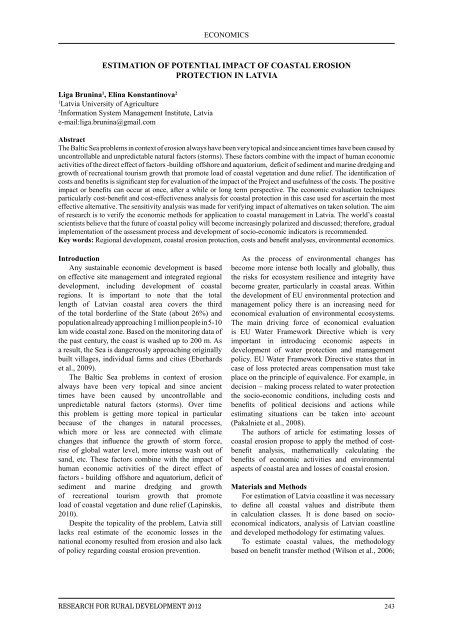RESEARCH FOR
RESEARCH FOR
RESEARCH FOR
You also want an ePaper? Increase the reach of your titles
YUMPU automatically turns print PDFs into web optimized ePapers that Google loves.
estImatIon of potentIal Impact of coastal erosIon<br />
protectIon In latvIa<br />
liga brunina 1 , elina Konstantinova 2<br />
1 Latvia University of Agriculture<br />
2 Information System Management Institute, Latvia<br />
e-mail:liga.brunina@gmail.com<br />
abstract<br />
The Baltic Sea problems in context of erosion always have been very topical and since ancient times have been caused by<br />
uncontrollable and unpredictable natural factors (storms). These factors combine with the impact of human economic<br />
activities of the direct effect of factors -building offshore and aquatorium, deficit of sediment and marine dredging and<br />
growth of recreational tourism growth that promote load of coastal vegetation and dune relief. The identification of<br />
costs and benefits is significant step for evaluation of the impact of the Project and usefulness of the costs. The positive<br />
impact or benefits can occur at once, after a while or long term perspective. The economic evaluation techniques<br />
particularly cost-benefit and cost-effectiveness analysis for coastal protection in this case used for ascertain the most<br />
effective alternative. The sensitivity analysis was made for verifying impact of alternatives on taken solution. The aim<br />
of research is to verify the economic methods for application to coastal management in Latvia. The world’s coastal<br />
scientists believe that the future of coastal policy will become increasingly polarized and discussed; therefore, gradual<br />
implementation of the assessment process and development of socio-economic indicators is recommended.<br />
Key words: Regional development, coastal erosion protection, costs and benefit analyses, environmental economics.<br />
Introduction<br />
Any sustainable economic development is based<br />
on effective site management and integrated regional<br />
development, including development of coastal<br />
regions. It is important to note that the total<br />
length of Latvian coastal area covers the third<br />
of the total borderline of the State (about 26%) and<br />
population already approaching 1 million people in 5-10<br />
km wide coastal zone. Based on the monitoring data of<br />
the past century, the coast is washed up to 200 m. As<br />
a result, the Sea is dangerously approaching originally<br />
built villages, individual farms and cities (Eberhards<br />
et al., 2009).<br />
The Baltic Sea problems in context of erosion<br />
always have been very topical and since ancient<br />
times have been caused by uncontrollable and<br />
unpredictable natural factors (storms). Over time<br />
this problem is getting more topical in particular<br />
because of the changes in natural processes,<br />
which more or less are connected with climate<br />
changes that influence the growth of storm force,<br />
rise of global water level, more intense wash out of<br />
sand, etc. These factors combine with the impact of<br />
human economic activities of the direct effect of<br />
factors - building offshore and aquatorium, deficit of<br />
sediment and marine dredging and growth<br />
of recreational tourism growth that promote<br />
load of coastal vegetation and dune relief (Lapinskis,<br />
2010).<br />
Despite the topicality of the problem, Latvia still<br />
lacks real estimate of the economic losses in the<br />
national economy resulted from erosion and also lack<br />
of policy regarding coastal erosion prevention.<br />
ReseaRch foR RuRal Development 2012<br />
ECONOMICS<br />
As the process of environmental changes has<br />
become more intense both locally and globally, thus<br />
the risks for ecosystem resilience and integrity have<br />
become greater, particularly in coastal areas. Within<br />
the development of EU environmental protection and<br />
management policy there is an increasing need for<br />
economical evaluation of environmental ecosystems.<br />
The main driving force of economical evaluation<br />
is EU Water Framework Directive which is very<br />
important in introducing economic aspects in<br />
development of water protection and management<br />
policy. EU Water Framework Directive states that in<br />
case of loss protected areas compensation must take<br />
place on the principle of equivalence. For example, in<br />
decision – making process related to water protection<br />
the socio-economic conditions, including costs and<br />
benefits of political decisions and actions while<br />
estimating situations can be taken into account<br />
(Pakalniete et al., 2008).<br />
The authors of article for estimating losses of<br />
coastal erosion propose to apply the method of costbenefit<br />
analysis, mathematically calculating the<br />
benefits of economic activities and environmental<br />
aspects of coastal area and losses of coastal erosion.<br />
materials and methods<br />
For estimation of Latvia coastline it was necessary<br />
to define all coastal values and distribute them<br />
in calculation classes. It is done based on socioeconomical<br />
indicators, analysis of Latvian coastline<br />
and developed methodology for estimating values.<br />
To estimate coastal values, the methodology<br />
based on benefit transfer method (Wilson et al., 2006;<br />
243


